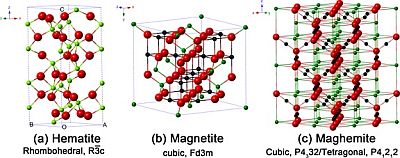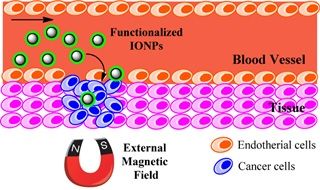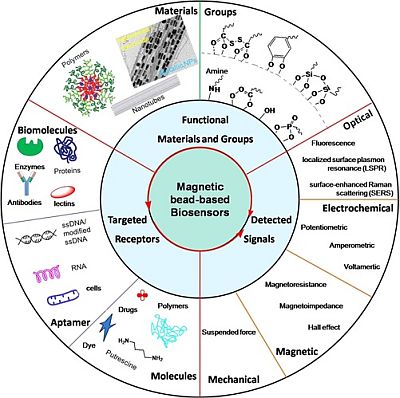|
|
|
|
|
|
| Recent developments and research related to iron oxide nanoparticles confirm their potential in biomedical applications - such as targeted drug delivery - and the necessity for further studies. |
TOKYO, Mar 15, 2016 - (ACN Newswire) - Iron oxides are widespread in nature and can be readily synthesized in the laboratory. Among them, hematite, magnetite and maghemite nanoparticles have particularly promising properties for biomedical applications.
 | | Crystal structures of hematite, magnetite and maghemite (black: Fe2+, green: Fe3+, red: O2-).
(Copyright: Science and Technology of Advanced Materials) |
 | | Schematic of magnetic nanoparticle based drug delivery system: drug-loaded IONPs are guided in vivo to the targeted tumour site using a high-gradient magnetic field.
(Copyright: Science and Technology of Advanced Materials) |
 | | Magnetic biosensor components
(Copyright: Science and Technology of Advanced Materials) |
Researchers in China and Korea reviewed recent studies on the preparation, structure and magnetic properties of iron oxide nanoparticles (IONPs) and their corresponding applications. The review, published in the journal Science and Technology of Advanced Materials, emphasized that the size, size distribution (the relative proportions of different-sized particles in a given sample), shape and magnetic properties of IONPs affect the location and mobility of IONPs in the human body. However, having complete control over the shape and size distribution of magnetic IONPs remains a challenge.
For example, magnetic IONPs are promising for carrying cancer drugs that target specific tissues. For this to happen, they are coated with a biocompatible shell that carries a specific drug. If this "functionalized" magnetic IONP is too large, it may be cleared from the blood stream. Thus, it is very important to be able to control the size of these particles. Researchers found that IONPs with diameters ranging from 10 to 100 nanometres are optimal for intravenous injection and can remain in the blood stream for the longest period of time.
The surface charge of IONPs is also important for their stability and how they interact with tissues. For example, breast cells uptake positively charged IONPs better than negatively charged ones. At the same time, positively charged IONPs are more rapidly cleared from the circulation. Negatively charged and neutral IONPs tend to remain longer in the circulation. The surface charge of IONPs can be controlled by using an appropriately charged functionalized material as a shell.
Other applications that can benefit from improving the functionality of magnetic IONPs include magnetic resonance imaging, magnetic hyperthermia and thermoablation (killing selected cancer cells with heat), and biosensing (detecting molecular interactions for disease diagnosis).
Further research is needed to evaluate the toxicity of both bare and functionalized IONPs.
The team's next focus will be on fabricating recyclable magnetic IONP catalysts and designing multifunctional biomedical applications, involving magnetic IONPs, that can play a dual role in diagnosing and treating disease, says Professor Wei Wu from China's Wuhan University.
For further information, please contact:
Wei Wu
Laboratory of Printable Functional Nanomaterials and Printed Electronics
School of Printing and Packaging
Wuhan University, People's Republic of China
E-mail: weiwu@whu.edu.cn
Image 1
https://www.acnnewswire.com/topimg/Low_STAM1603151.jpg
Caption: Crystal structures of hematite, magnetite and maghemite (black: Fe2+, green: Fe3+, red: O2-).
Copyright: Science and Technology of Advanced Materials
Image 2
https://www.acnnewswire.com/topimg/Low_STAM1603152.jpg
Caption: Schematic of magnetic nanoparticle based drug delivery system: drug-loaded IONPs are guided in vivo to the targeted tumour site using a high-gradient magnetic field.
Copyright: Science and Technology of Advanced Materials
Image 3
https://www.acnnewswire.com/topimg/Low_STAM1603153.jpg
Caption: Magnetic biosensor components
Copyright: Science and Technology of Advanced Materials
More information about the research paper
Sci. Technol. Adv. Mater. 16 (2015) 023501
doi:10.1088/1468-6996/16/2/023501
http://tandfonline.com/doi/full/10.1088/1468-6996/16/2/023501
Reviews
Recent progress on magnetic iron oxide nanoparticles: synthesis, surface functional strategies and biomedical applications
Wei Wu, Zhaohui Wu, Taekyung Yu, Changzhong Jiang & Woo-Sik Kim
Journal information:
Science and Technology of Advanced Materials (STAM) is the leading open access, international journal for outstanding research articles across all aspects of materials science. Our audience is the international materials community across the disciplines of materials science, physics, chemistry, biology as well as engineering.
The journal covers a broad spectrum of materials science research including functional materials, synthesis and processing, theoretical analyses, characterization and properties of materials. Emphasis is placed on the interdisciplinary nature of materials science and issues at the forefront of the field, such as energy and environmental issues, as well as medical and bioengineering applications.
http://tandfonline.com/loi/tsta20#.VuIRGmfotYV
For more information about the journal Science and Technology of Advanced Materials, contact:
Mikiko Tanifuji
Publishing Director
Science and Technology of Advanced Materials
Email: TANIFUJI.Mikiko@nims.go.jp
Press release distributed by ResearchSEA for Science and Technology of Advanced Materials.
Topic: Research and development
Source: Science and Technology of Advanced Materials
Sectors: Science & Nanotech, Science & Research, BioTech
https://www.acnnewswire.com
From the Asia Corporate News Network
Copyright © 2024 ACN Newswire. All rights reserved. A division of Asia Corporate News Network.
|
|
|
|

|
|
|
|